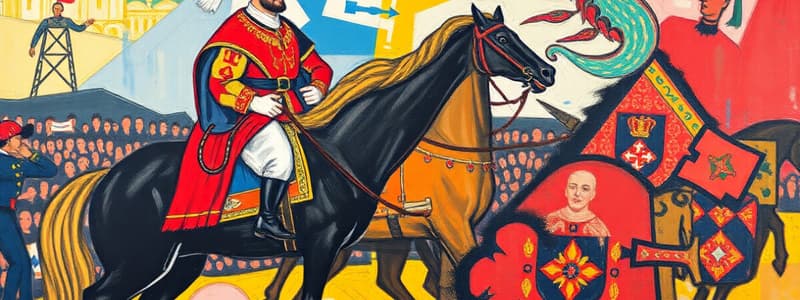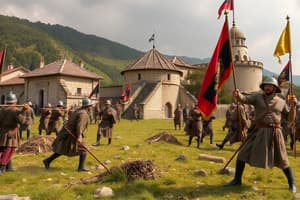Podcast
Questions and Answers
Which factor contributed most significantly to Serbia's initial economic reliance on Austria during the reign of King Milan Obrenovic?
Which factor contributed most significantly to Serbia's initial economic reliance on Austria during the reign of King Milan Obrenovic?
- Austria's dependence on Serbian agricultural exports, particularly pork.
- Serbia's imposition of high tariffs on Austrian goods.
- Milan Obrenovic's focus on developing trade relationships with France and Russia.
- Extensive Austrian railway networks facilitating trade in Serbian goods. (correct)
What was the primary goal of Pan-Slavism in the context of early 20th-century Europe?
What was the primary goal of Pan-Slavism in the context of early 20th-century Europe?
- Maintaining the existing political boundaries of the Austro-Hungarian Empire.
- Creating a unified nation for all Slavic people in Southern Europe by liberating them from Austro-Hungarian rule. (correct)
- Establishing economic partnerships between Austria-Hungary and Balkan states.
- Promoting Austrian expansionism throughout the Balkan region.
How did King Peter's rule differ from that of his predecessor, King Alexander, in terms of political ideology and international relations?
How did King Peter's rule differ from that of his predecessor, King Alexander, in terms of political ideology and international relations?
- King Peter was more autocratic and fostered closer ties with Austria, while King Alexander embraced democratic reforms and aligned with France and Russia.
- Both rulers maintained pro-Austrian stances and suppressed political freedoms, differing only in their methods.
- King Peter transformed Serbia into a constitutional, democratic state and sought alliances with France, Russia, and Bulgaria, whereas King Alexander was an unpopular autocrat. (correct)
- King Peter focused on consolidating power through oppression, while King Alexander sought to relax political tensions.
Which of the following best explain the 'Pig War?'
Which of the following best explain the 'Pig War?'
What was Austria-Hungary's perspective on Serbia's growing power and influence in the Balkans?
What was Austria-Hungary's perspective on Serbia's growing power and influence in the Balkans?
What led to increased tensions between Serbia and Austria-Hungary in the early 20th century?
What led to increased tensions between Serbia and Austria-Hungary in the early 20th century?
Which of the following best describes Serbia's position in the Balkans following the Balkan Wars (1912-1913)?
Which of the following best describes Serbia's position in the Balkans following the Balkan Wars (1912-1913)?
How did King Peter's approach to governance influence political freedoms within Serbia?
How did King Peter's approach to governance influence political freedoms within Serbia?
Flashcards
Pan-Slavism
Pan-Slavism
A political ideology emphasizing the unity and cooperation of all Slavic peoples.
Serbia's Independence
Serbia's Independence
Achieved self-governing principality in 1830 and full independence in 1878.
Serbia's early alignment with Austria
Serbia's early alignment with Austria
Serbia was economically dependent and influenced by Austria.
King Peter's shift in Serbia
King Peter's shift in Serbia
Signup and view all the flashcards
The 'Pig War'
The 'Pig War'
Signup and view all the flashcards
Pan-Slavism's Aim
Pan-Slavism's Aim
Signup and view all the flashcards
Bosnian Crisis & Balkan Wars
Bosnian Crisis & Balkan Wars
Signup and view all the flashcards
Austrian-Serbian tensions
Austrian-Serbian tensions
Signup and view all the flashcards
Study Notes
- Serbia became a self-governing principality from the Ottoman Empire in 1830 and an independent nation-state in 1878
- The newly independent Serbia was subject to external pressures from Austria, Russia, Western liberal ideas, and its own intense nationalism
- The kingdom's early years consisted of intrigue, instability, political rivalry and a failed war with Bulgaria
Alignment with Austria
- King Milan Obrenovic was pro-Austrian and aligned Serbia with Vienna
- Austria became Serbia's largest purchaser of agricultural exports, including livestock, wheat, and fruit
- Austrian-owned railways crisscrossed Serbian territory, and Austrian banks lent to Serbian businesses greatly
- By the 1880s, Serbia became economically dependent on Austria, with the king viewed as a puppet ruler controlled by Vienna
- This situation displeased Serbian intellectuals, who sympathized with Russia and feared Austrian expansionism
New Dynasty, New Goals
- After the assassination of King Alexander, a new dynasty came to power
- King Peter, educated in Paris and a veteran of the Franco-Prussian War, modernized the nation
- King Peter transformed Serbia into a constitutional, democratic state with a modern economy
- After gaining power, Peter enacted a Western-style constitution in 1903
- He also passed a political amnesty, relaxed laws, and abolished press censorship
- This liberalization proved popular among native Serbians and other Slavic peoples in the Balkans
- Slavs viewed Serbia as a safe harbour for Slavic identity and culture
- The Greater Serbia movement called for reclaiming Serbian territory from the Ottoman and Austro-Hungarian empires
- Pan-Slavism called for the liberation of Slavs under Austrian rule
- Some believed Serbia should form into Yugoslavia, a single nation for all Slavic peoples of southern Europe
- King Peter realigned Serbia away from Austrian influence, brokering good relations and trade deals with France, Russia, and Bulgaria
- Serbia began to trade freely after two decades as an Austro-Hungarian satellite
- In 1906 Austria initiated trade sanctions, banning future purchases of Serbian pork (one of its main exports)
- The "Pig War" lasted three years and was a victory for Serbia whose economy diversified and grew as a result
- Tensions increased due to the Bosnian crisis (1908-9) and Balkan Wars (1912-13)
- Serbia's military victories caused the balance of power to shift
- Serbia gained territory and people, doubling in size and growing by 1.6 million people
- This made Serbia one of the largest states in southern Europe and militarily powerful in the Balkans
- Expansionist Austrians viewed Serbia as troublemakers that could destabilize its fragile empire
- Military planners in Vienna spoke of crushing Serbia, seeking a pretext for war
- Many in Serbia believed their nation and Slavic people were threatened by an expansionist power
- Pan-Slavic nationalist groups formed with two aims: to protect the rights of Slavic people and to drive Austria-Hungary out of the Balkans
Studying That Suits You
Use AI to generate personalized quizzes and flashcards to suit your learning preferences.




